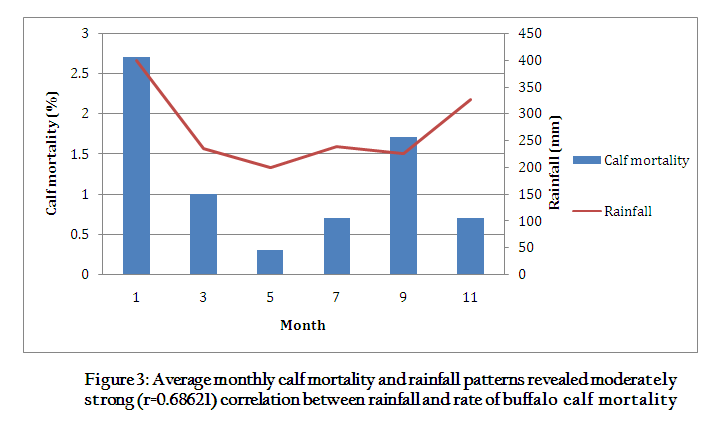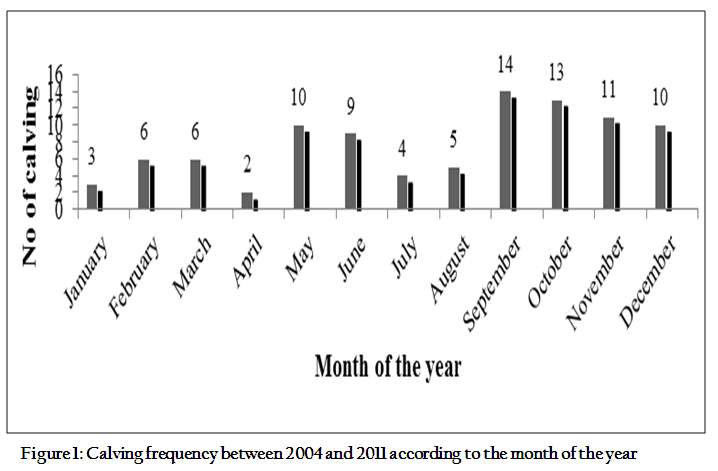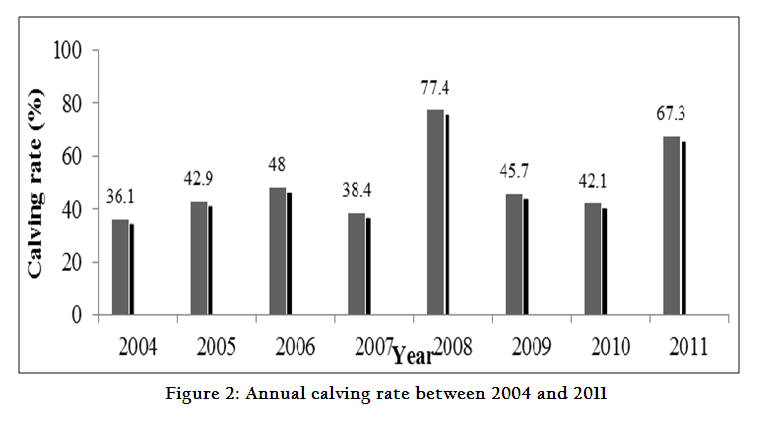Journal of Animal Health and Production
Research Article
Journal of Animal Health and Production 2 (1): 1 – 4Improving the Reproductive Performance of Buffaloes in Sabah, Malaysia
Rafidah Othman1,4, Muhammad Zuki Abu Bakar2, Azhar Kasim3, Muhammad Zamri–Saad1*
- Research Centre for Ruminant Diseases, Faculty of Veterinary Medicine, Universiti Putra Malaysia, 43400 Serdang, Malaysia;
- Department of Veterinary Preclinical Sciences, Universiti Putra Malaysia, 43400 Serdang, Malaysia;
- Department of Animal Science, Faculty of Agriculture, Universiti Putra Malaysia, 43400 Serdang, Malaysia;
- Department of Veterinary Services and Animal Industry Sabah, Kota Kinabalu, Malaysia
*Corresponding author: mzamri@upm.edu.my
ARTICLE CITATION:
Othman R, Bakar MZA, Kasim A and Zamri–Saad M (2014). Improving the reproductive performance of buffaloes in Sabah, Malaysia. J Anim Health Prod. 2 (1): 1 – 4.
Received: 2014–01–01, Revised: 2014–01–23, Accepted: 2014–01–24
The electronic version of this article is the complete one and can be found online at
(
http://dx.doi.org/10.14737/journal.jahp/2014/2.1.1.4
)
which permits unrestricted use, distribution, and reproduction in any medium, provided the original work is properly cited
ABSTRACT
A buffalo–breeding farm was selected to study the reproductive performance. The farm consisted of 398.5 acres of pasture with a total of 335 heads of buffaloes, practicing extensive grazing system without supplementation. At the start of the study, at the end of 2011, farm records between 2004 and 2011 were analysed for selected reproductive parameters. Following the analysis, attempts were made to improve the performance by improving feed and feeding, herd health and breeding program. The interventions, in January 2012, included reducing the numbers of breeder buffaloes from 250 to 158 heads while the pasture area was increased from 398.5 to 441.5 acres. Proximate analysis of the grass was carried out and yearly vaccination against haemorrhagic septicaemia was recommended. The fecal samples were analysed for internal parasites particularly the liver flukes. The 158 selected breeder buffaloes were flushed by providing supplemented palm kernel cake–based feed at the rate of 1.5kg/animal/day for 2 weeks before breeder males were introduced at the rate of 1 male to 20 females. Between 2004 and 2011, a total of 442 calves were born (average of 55 calves/year or 22%); One hundred and thirty (52%) females calved only once, 73 (29%) calved twice, 35 (14%) calved 3 times and 12 (5%) calved 4 times. Most (52%) calving were recorded during the rainy months of September to December. The average annual calving rate was 49.7+14.7%, the calving interval was 24+11.2 months and calf mortality was 26.8+7.0%, significantly (p<0.05) more during rainy season. Following intervention in early 2012, proximate analysis of the grass revealed improvement on the average crude protein content from 7.6% to 12%. With supplementation, the percentage of breeder female with body score of >3 increased from 79% to 95%. The improved body score enhanced the pregnancy rate from 49% to 71% and subsequently the calving rate from 42% to 82%. Similarly, the mortality rate was significantly reduced from 11.3% to 5.2%.
INTRODUCTION
There are two distinct types of Asian water buffalo, the Riverine (Murrah) type that populate the Indian continent, including India, Pakistan, Bangladesh, Sri Lanka and Nepal and the swamp type that populate the East and Southeast Asian (SEA) countries, including China, Thailand, the Philippines, Laos, Cambodia, Vietnam, Indonesia, Malaysia and Myanmar. The Murrah breed remains with robust growth rate while the swamp buffaloes have been on the decline (Cruz, 2010). However, buffalo owes a high economic importance for farmers in many developing countries, particularly in Asia (Cruz, 2010). They are kept mostly on small farms as they can utilize relatively poor digestible feeds and provide milk, meat, hide and draft power (Yindee, 2011). Therefore, their reproductive performance is generally poor (Nanda et al., 2003). This paper retrospectively analyses the reproductive performance of buffaloes kept at a breeding farm in Sabah, Malaysia and describes their performance following interventions with improved rearing system.
MATERIALS AND METHODS
The Farm
This study involved a 749–acre buffalo–breeding farm located at Telupid, Sabah, Malaysia (5o 30’ N, 117o 7’ E). At the start of the study, the farm had a total of 335 heads of buffalo. Of these, 180 were breeder females, 78 breeder heifers, 7 breeder males and 70 calves (51 females and 19 males). Fifty percent of the breeder females were Murrah–swamp crossbred buffaloes while all breeder males were Murrah–swamp crossbreds. The 398.5 acres of pastureland were divided into paddocks with established pasture (Brachiaria decumbens) and wallowing sites. Although the pasture was generally poorly maintained, the farm practiced an extensive 30–day rotational grazing system without feed supplementation. Natural breeding was used, with male and female ratio of 1:20.
Pre–Intervention
At the start of the study, 8–year farm records between 2004 and 2011 were selected and analysed retrospectively for selected reproductive parameters. Among the parameters analysed included the calving frequency, calving pattern, calving rate, calving interval and calf mortality. At the same time, pasture samples were collected from two paddocks, each paddock at 6 sites of 1m2 area for proximate analysis of the nutrient contents (Galyean, 2010).
The Intervention
The interventions were implemented in January 2012. These included the use of organic fertilizer on pasture at the rate of 20 tonnes of organic fertilizer supplemented with 500kg of urea to improve the pasture. After 6 months, pasture samples were collected from the two paddocks, each paddock at 6 sites of 1m2 area for re–analysis of the proximate nutrient contents. At the same time, the breeder females that either failed to conceived for 3 years, had body score of <3 out of 5 score (Anitha et al., 2011) or of more than 15 years old were excluded from the breeding program. The selected breeder females were re–grouped into 20–head per group according to the body weight and were flushed by providing supplemented feed at the rate of 500g/animal/day for 14 days before a breeder male was introduced in January 2012 for a period of 3 months. After 3 months, pregnancy diagnosis was performed on all breeder females. The pregnant buffaloes were re–grouped into 20–head per group according to the body weight while the non–pregnant females were prepared again for breeding by providing supplemented feed at 500g/animal/day for 14 days before breeder male was re–introduced. The procedure was repeated one more time before the non–pregnant breeder females were culled.
RRESULT
Retrospective Reproductive Performance
Between 2004 and 2011, a total of 442 calves were born with an average of 55 (22%) calves/year. Within the same period, 130 (52%) (p<0.05) of the breeder females calved only once, 73 (29%) calved twice, 35 (14%) calved 3 times and 12 (5%) calved 4 times. Most (52%) calving (p<0.05) were reported during the rainy months of September to December while the least (18%) calving were reported during the dry months of January to April (Figure 1). Highest numbers of calving were reported in September and lowest numbers were in April (p<0.05). The annual calving rate ranged between 36.1% and 77.4% with an average rate of 49.7+14.7% (Figure 2). The highest calving rate was recorded in 2008. The calving interval ranged between 14 and 56 months with an average calving interval of 24+11.2 months.
The annual calf mortality rate ranged between 16.4% and 37.2% with an average of 26.8+7.0% (Table 1). The highest rate of calf mortality was in 2007, the same year that showed highest calving rate. Similarly, the year 2009 showed the lowest rate of calf mortality coincided with the lowest calving rate (Table 1). There was moderately strong correlation (r=0.68621) between calf mortality and the rainfall with high calf mortality during the rainy months of October to January (Figure 3).

Figure 3: Average monthly calf mortality and rainfall patterns revealed moderately strong (r=0.68621) correlation between rainfall and rate of buffalo calf mortality
Prior to intervention, proximate analysis of the pasture in 2011 revealed that the average crude protein content was 7.6+1.00%.The average content of acid detergent fibre (ADF) was 44.73+0.96 while the neutral detergent fibre (NDF) was 81.24+1.30.
Reproductive Performance Following Farm Interventions
Following selection exercise, a total of 73 (32%) breeder females were culled following previous poor reproductive performance leaving a total of 158 (68%) breeder females were selected for breeding. Three new breeder males of swamp breed were introduced into the farm for breeding purposes. Natural breeding was carried out in January 2012, involving the 158 breeder females and 9 breeder males.
Between January 2012 and June 2013, following activities to improve the farm and implementation of the breeding program, proximate analysis of the pasture revealed 12% crude protein while flushing resulted in 150 (95%) breeder females with body score of >3.0 and ready for breeding. Introduction of bull resulted in 107 (71%) of breeder females to be pregnant, of which 88 (82%) calved down. A further 15 breeder females that failed to conceive after the 3 breeding attempts or of less than 360kg body weight were culled, leaving the current breeder females to 143 heads. Implementation of herd health reduced calf mortality to 5.2%.
DISCUSSION
Buffalo heifers attain puberty between 3 and 5 years of age (Nanda et al., 2003) while age at first calving ranged between 36 and 56 months with an average of 42 months (Tuyen and Ly, 2001). However, young heifers failed to enhance the reproductive performance in this farm instead, experienced breeders were observed to calved–down throughout the year. It is interesting to note that calving in this farm were most frequently recorded during the rainy months of September to December. This is in agreement with the findings in Thailand (Yindee, 2011). Since the gestation period in buffalo is approximately 10 months (Tuyen and Ly, 2001), most mating in this farm took place during the wet months between November and January. Earlier study by Sule et al. (2001) has concluded that dry or summer season is less suitable for mating. Therefore, breeder females must be prepared for breeding during the wet months and since nutrition is an important factor that influences the reproductive performance (Qureshi et al., 2002), breeders should be allowed to graze on improved pasture and provided with supplemented feed to improve the fertility (Sorio, 2010).
It was reported that the calving interval for buffalo ranged between 15 months for Murrah buffaloes in India (Campanile et al., 2003) and 18 months (range between 15 and 21 months) for swamp buffaloes (Tuyen and Ly, 2001) as compared to an average of 24 months in this study. Various factors are responsible for the poor performance, including seasonal stress with suboptimal nutrition (McCool, 1992), unfavourable climate, mismanagement and diseases (Parera, 2008). Furthermore, the Brachiaria decumbens in this farm was found to be nutritionally inferior (Fukumoto and Lee, 2002). When properly managed with efficient grazing and supplemented feeding, buffalo can have good fertility and provide milk, calves and draught power over a long productive life (Parera, 2008; Sorio, 2010).
A study in Pakistan revealed an average of 17.98% mortality rate among buffalo calves (Khan et al., 2007), which was much lower than reported in this study. However, a report from India revealed extremely high rate of 81.09% in dairy buffalo farms (Tiwari et al., 2007). The mortality among buffalo calves is high during 3rd to 4th week of life (Panchasara et al., 2009) and during monsoon season, followed by winter (Panchasara et al., 2009). Similar correlation with wet months was observed in this study.
ACKNOWLEDGEMENTS
This project was financially supported by the research grant (I–gt/15 (UPM) from the Ministry of Higher Education (MOHE) and the Economic Planning Unit (EPU) Malaysia. The technical support from Mr. Jafred Tudok, Manager of the farm and official approval by the Director, Department of Veterinary Services Sabah are greatly appreciated.
CONFLICT OF INTEREST
No conflict of interest.
REFERENCES
Anitha A, Sarjan Rao K, Suresh J, Srinivasa Moorthy PR and Kotilinga Reddy Y (2011). A body condition score (BCS) system in murrah buffaloes. Buff. Bull. 30(1): 79–99.
Cruz LC (2010). Recent developments in the buffalo industry of Asia. In; Proceedings of the 9th World Buffalo Congress, Buenos Aires, Argentina, (April 25-28, 2010).
Campanile G, Di Palo R, Infascelli F, Gasparrini B, Neglia G, Zicarelli F and D'Occhio MJ (2003). Influence of rumen protein degradability on productive and reproductive performance in buffalo cows. Reprod. Nutri. Dev. 43: 557–566.
http://dx.doi.org/10.1051/rnd:2004008.
PMid:15141439
Fukumoto GK and Lee CN (2002). Signalgrass for forage.
http://www2.ctahr.hawaii.edu/oc/freepubs/pdf/lm-3.pdf
Galyean MM (2010). Laboratory Procedures in Animal Nutrition Research. Department of Animal and Food Science, Texas Tech University, Lubbock
Khan ZU, Khan S, Ahmad N and Raziq A (2007). Investigation of mortality incidence and managemental practices in buffalo calves at commercial dairy farms in Peshawar City. J. Agric. Biol. Sci. 2: 16–21
McCool C (1992). Buffalo and Bali cattle–exploiting their reproductive behaviour and physiology. Trop. Anim. Health Prod. 24: 165–172. .
http://dx.doi.org/10.1007/BF02359609
PMid:1304664
Nanda AS, Barr PS and Prabhakar S (2003). Enhancing reproductive performance in dairy buffalo: major constraints and achievements. Reprod. (Suppl.) 61: 27–36.
PMid:14635924
Panchasara HH, Sutaria TV and Shah RR (2009). Factors affecting mortality of Mehsana buffalo calves. Intas Polivet. 10: 170–173
Perera BM (2008). Reproduction in domestic buffalo. Reprod. Domestic Anim. (Suppl. 2) 43: 200–206
http://dx.doi.org/10.1111/j.1439-0531.2008.01162.x
PMid:18638124
Qureshi MS, Habib G, Samad HA, Siddiqui MM, Ahmad N and Syed M (2002). Reproduction–nutrition relationship in dairy buffalo. I., Effect of intake of protein, energy and blood metabolites levels. Asian–Australian J. Anim. Sci. 15: 330–339
Sorio H (2010). Technical and economic results of the application of voisin grazing with buffalo on two farms from Venezuela. In: Proceedings of the 9th World Buffalo Congress, Buenos Aires, Argentina, (April 25-28, 2010).
Sule SR, Taparia AL, Jain LS and Tailor SP (2001). Reproductive status of Surti buffaloes maintained under sub–humid conditions of Rajasthan. Indian Vet. J. 78: 1049–1051
Tiwari R, Sharma MC and Singh BP (2007). Buffalo calf health care in commercial dairy farms: a field study in Uttar Pradesh (India). Livestock Research and Rural Development. 19, Article #38; http://www.lrrd.org/lrrd19/3/tiwa19038.htm
Tuyen DK and Ly NV (2001). The role of swamp buffalo in agricultural production of small farm holder. In: Proceedings of the Buffalo Workshop, Vietnam.
http://www.mekarn.org/procbuf/tuye.htm
Yindee M (2011). Reproduction and genetic diversity of the swamp buffalo.
http://www.vetscite.org/publish/articles/000096/index.html







